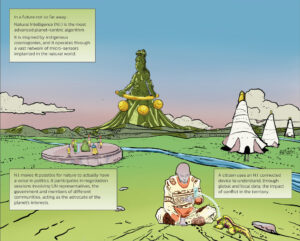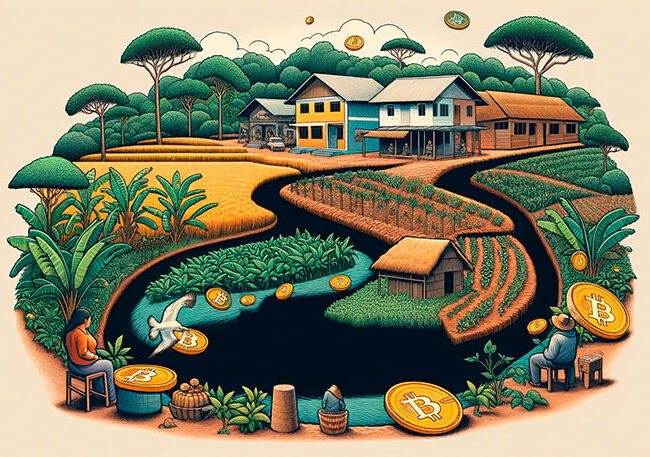Our provocations
[Pilot] Voice and Vote to Water: Integrating Artificial Intelligence and the Muisca Cosmovision for Water Prosperity.
In brief:
Inspired by our future vision of 2045 Natural Intelligence – The Voice of Nature (2020), this pilot is a pioneering initiative that combines conversational Artificial Intelligence (CAI) and Internet of Things (IoT) with the Muisca indigenous cosmovision to give voice to water at the dialogue table on sustainable territorial prosperity in the Indigenous Reservation ‘Los Hijos del Maíz’ in Sesquilé, Cundinamarca.
The initiative, accompanied and closely followed by the Pluriversa team, aims to promote alternatives to the current development model and disseminate the local indigenous culture, integrating water needs and ancestral values in decision-making and pluriversal territorial planning.
Location:
Mhuysqa Chuta Fa Aba Indigenous Reservation “Los Hijos del Maíz”, in the municipality of Sesquilé, Cundinamarca, Colombia.
Sector:
Environmental and water conservation, water management, Artificial Intelligence, Internet of Things
A Provocation by:
- Miguel Bello

General Objective
Give voice and vote to water in intercultural and multisectorial dialogues of territorial prosperity, integrating conversational Artificial Intelligence with the Muisca cosmovision to promote environmentally friendly practices and local culture in the surroundings of the Indigenous Reservation “Los Hijos del Maíz” in Sesquilé, Cundinamarca.
Give voice and vote to water in intercultural and multisectorial dialogues of territorial prosperity, integrating conversational Artificial Intelligence with the Muisca cosmovision to promote environmentally friendly practices and local culture in the surroundings of the Indigenous Reservation “Los Hijos del Maíz” in Sesquilé, Cundinamarca.
Specific Objectives
- Document and disseminate Muisca knowledge and practices related to water for its recognition and valuation.
- Implement a conversational Artificial Intelligence (CAI) that represents water’s voice, interests, and needs, trained based on the Muisca cosmovision and current environmental data.
- Install IoT sensors to monitor the conditions of the water and natural environment in Sesquilé in real-time, providing accurate and updated data to the CAI.
- Employ the CAI as a spokesperson for water and nature in intercultural and multisectoral dialogue spaces for territorial prosperity decision-making involving the Muisca community, local economic actors (farmers, ranchers, industrialists), and local governmental entities.
- Promote environmental education and awareness among participants, reinforcing the value of the Muisca cosmovision and the importance of adopting sustainable and environmentally friendly practices in water management.
- Promote the creation of a water and territorial management model that is co-created and sustained by all stakeholders, ensuring the effective integration of their interests and needs.
- Establish a replicable and scalable model of rights of nature for pluriversal territorial prosperity and ancestral recovery, recognizing the voice of water in territorial decisions.
- Establish measurement and monitoring systems with the support of Pluriversa to identify barriers, make adjustments, and evaluate the impact of the pilot.
Hypothesis
By integrating a CAI representing the voice of water, based on the Muisca cosmovision and supported by real data through IoT, it is expected to foster greater empathy and understanding towards water resources and indigenous culture, promoting a model of territorial prosperity that is pluriversal, sustainable, inclusive and collaborative.
Approach
Relevant Social Actors
Target community: Indigenous Reservation "Los Hijos del Maíz"
The Colombian National Land Agency carried out an administrative process for the constitution of the Indigenous Reservation Mhuysqa Chuta Fa Aba “Los Hijos del Maíz” in Sesquilé, Cundinamarca. This legal action formally recognizes a specific territory as an indigenous reservation, thus providing a legal framework for land management and protection by the Muisca indigenous community. This process has taken into account:
Participation of the Muisca Community: the Muisca indigenous community has been actively involved. This includes the identification of the boundaries of the intended area and participation in virtual meetings and autonomous territorial identification exercises.
Focus on Conservation and Culture: The reservation seeks to maintain and strengthen the Muisca indigenous community’s cultural and spiritual relationship with its territory. It includes collective projects such as the restoration of the Tchunzuá Ceremonial Center and the reconstruction of ceremonial houses.
Payments for Environmental Services (PES) Programs: The implementation of PES stands out, with a particular focus on intangible ancestral and cultural services. These programs provide economic benefits to indigenous communities in exchange for the conservation and sustainable management of their ecosystems.
Support from the Regional Conservation Authority (CAR): The CAR has worked hand in hand with the indigenous community, supporting initiatives such as the BancO2 Program and other PES. This reflects a positive collaboration between the regional authorities and the indigenous communities for the sustainable management of natural resources.
External Contributions and Support: The BancO2 program and PES have been possible thanks to donations from individuals and entities, demonstrating a broader commitment to the well-being and conservation of the territory administered by CAR.
Resources Needed
- IoT sensors and environmental monitoring equipment: For real-time data capture of water conditions and nature.
- Historical water data: To train the model based on water quality and health changes over time.
- Equipment and software for CAI and data analysis: It is necessary to enable and train the CAI model.
- Muisca worldview and postdevelopment experts: To understand indigenous worldviews of water and to train the CAI model based on local indigenous culture and traditions. Ensuring that Muisca’s knowledge is correctly integrated and represented in the CAI is essential.
- Experts in design, CAI, IoT, and environment: To design and train the CAI model and facilitate community dialogue spaces.
- Experts in Big Data and data analysis: Necessary to interpret the information IoT sensors collect.
- Spaces and resources for workshops, training, and dissemination: It is necessary to involve the stakeholder community in the dialogues and processes of the pilot.
- Communication and dissemination tools: To disseminate the participatory dialogues, the pilot’s progress, and results.
- Funding: To cover human talent, travel expenses, research, training, technology, follow-up, and other operational costs.
- Internet access: Although many rural and jungle communities currently have Internet access, this must be guaranteed on a case-by-case basis.
Optionally, with additional funds, it is possible to create a documentary that tells the story of the experience and the lessons learned.
Estimated Times
Preparatory Phase (1 month): Stakeholder identification, preliminary data collection, preparation of materials, and initial coordination.
Planning and Development Phase (3 months): CAI training, procurement and configuration and installation of IoT sensors, workshop planning, and community dialogues.
Testing and Iteration Phase (1 month): Initial testing of the IoT model and iteration.
Implementation Phase (3 months): Launching the CAI, conducting workshops and community dialogues. Opening of the model to other communities.
Evaluation and Scaling Phase (1 month): Feedback, impact evaluation, adjustments, and planning to replicate the model in other regions.
Conclusion
The “Voice and Vote to Water” pilot in Sesquilé, Cundinamarca, is a pioneering project that fuses Muisca ancestral wisdom with advanced technologies, such as conversational Artificial Intelligence (CAI) and the Internet of Things (IoT), to give water a voice in decision-making processes for sustainable water management and territorial prosperity.
This project seeks not only to generate alternatives to the territorial development model but also to establish how technology can respect and amplify the rich Muisca cosmovision in the region. It acts as a bridge between diverse cultures, disciplines, and communities, integrating local actors, indigenous leaders, and technology experts in a respectful dialogue. Its potential for replicability in other communities suggests a path towards sustainable and culturally appropriate solutions, promoting a harmonious and sustainable relationship between humanity and nature.
FAQ - Key questions
1. Why the Muisca community of Sesquilé?
The pilot 'Voice and Vote to Water' in the Muisca community of Sesquilé is based on the Muisca's deep spiritual and cultural connection with water. In their worldview, water is sacred, reflected in rituals and offerings in ponds and water sources. Muisca mythology, rich in references to water, includes places such as the Bogotá River and the Iguaque Lagoon, central to their religious practices. However, colonization drastically altered these traditions, negatively impacting water sources and soil. Now, the Sesquilé region and the 'Los Hijos del Maíz' reservation face environmental challenges due to agricultural and livestock exploitation.
This project seeks to mitigate these impacts and preserve water-related traditions. Despite westernization and colonization, the veneration of water and aquatic entities such as snakes has survived in certain campesino practices, keeping alive the local culture of respect and protection of water sources.
2. Why are Conversational Artificial Intelligence and the Internet of Things relevant?
The use of Conversational Artificial Intelligence (CAI) and the Internet of Things (IoT) in our 'Voice and Vote to Water' pilot is crucial for several reasons. The CAI, leveraging technologies such as natural language processing and machine learning, allows water, a sacred element in the Muisca cosmovision, to have a 'voice' in the discussions. This symbolizes its importance, ensuring that its needs are considered in territorial development decisions. In addition, the CAI facilitates dialogue between different stakeholders, processing and communicating complex information in an understandable way, which helps build common understanding and raises awareness of environmental and cultural issues.
On the other hand, IoT connects physical devices, equipped with sensors and processing technology, to transmit real-time information about water quality and environmental conditions. This data enriches the CAI, enabling accurate representations of the conditions and needs of water and the natural environment. In addition, IoT sensors can provide early warnings about environmental changes, enabling quick and efficient responses to emerging problems. This combination of advanced technologies with ancestral knowledge represents an innovative and respectful approach to environmental and development issues, promoting education, awareness and inclusive participation in the decision-making process.
3. What do we intend to do, why is it important and what do we expect the impact of the pilot to be?
The "Voice and Vote to Water" project in Sesquilé, Cundinamarca, focuses on reviving the Muisca cosmovision and offering alternatives to territorial development and water management, in a context affected by agricultural and tourism development. The integration of Conversational Artificial Intelligence (CAI) and IoT sensors will give "voice" to water, allowing its participation in management and conservation decisions. AI, trained on Muisca cosmovision and current environmental data, together with real-time IoT data, will enrich conversations, combining ancestral and contemporary perspectives.
This approach seeks not only to solve environmental problems, but also to educate and raise awareness about sustainable water management and respect for indigenous culture. Involving the Muisca community, farmers, entrepreneurs and government entities, the project proposes a model of environmental governance that is fair and sustainable, respecting ancestral traditions. The objective is to establish a new paradigm in natural resource management, where nature itself is a key participant, creating an impact on cultural preservation, sustainable water practices and participatory environmental governance.
4. What is innovative about our pilot?
This pilot marks a milestone in the integration of environmental sustainability and cultural conservation, fusing advanced technology with Muisca ancestral wisdom. Its innovative character is reflected in the use of Conversational Artificial Intelligence (CAI), trained with Muisca and environmental principles and data, to give symbolic voice to water, actively integrating it into decision making and reflecting both ancestral knowledge and current concerns. This unique approach makes water a key player in negotiations, fostering a cross-cultural and multi-sectoral dialogue between indigenous communities, farmers, entrepreneurs, and government entities, and establishing an innovative model for recognizing the rights of nature.
This project stands out not only for its cross-cultural and collaborative approach, but also for its practical application of IoT to collect environmental data in real time, enriching CAI and supporting evidence-based decisions. It represents a cutting-edge approach that addresses environmental and cultural challenges holistically, demonstrating the potential of technology to empower communities and protect nature, and offering a replicable and scalable model for the inclusion of nature in environmental decision-making.
5. What do we hope to learn from the pilot?
In the "Voice and Vote to Water" pilot, we seek to learn how advanced technology, such as Conversational Artificial Intelligence (CAI) and IoT sensors, can be integrated with the worldviews and ancestral practices of indigenous communities, in particular the Muisca community. This knowledge will be key to understand the interaction between ancestral wisdom and modern technology in solving environmental and cultural challenges. In addition, we hope to understand the dynamics of collaboration between diverse actors, including indigenous communities, entrepreneurs, farmers, and governmental entities, and how to facilitate intercultural dialogue and negotiation of interests to achieve common goals of sustainability and respect for nature.
We also aim to assess the impact of giving nature a symbolic voice in decision-making and learn how a rights-based approach to nature can influence territorial development and its viability in other contexts. We seek effective methods to measure the environmental and cultural impact of our actions, and address the practical and technical challenges of implementing environmental technologies such as IoT sensors. These learnings will be fundamental to validate and improve our strategies, promoting a more conscious and sustainable environmental governance model.
6. What have we done to help communities create a better future and how do we want to involve them in this pilot?
At Pluriversa, we are committed to communities and postdevelopment, adopting an inclusive and participatory approach. Our work focuses on creating a better future by integrating different actors in the search for innovative solutions to environmental and cultural challenges.
Our previous work includes the speculative design project Natural Intelligence - the Voice of Nature, and the creation of futuristic scenarios for the use of blockchain in post-development. We have participated in the design and implementation of digital solutions for B2C and B2B markets in the financial and energy sector in Colombia, Mexico and Peru, which gives us a solid foundation for this project.

Natural Intelligence - The Voice of Nature. 🥇 Winner of the Futuring Peace Competition issued by UN’s DPPA. 2020.
In our pilot, active community involvement is fundamental. We collaborate closely with local leaders and experts, including specialists in Muisca cosmovision and environmental technologies, to ensure that our initiatives respond to community realities and needs. Through open dialogues and interactive workshops involving diverse local stakeholders, we promote mutual understanding and joint exploration of solutions for sustainable territorial development that respects the environment and indigenous culture. We employ participatory research methods, focusing community perspectives and knowledge in our inquiries, and foster collaborative ecosystems that connect communities with a broad spectrum of stakeholders. In addition, we focus on environmental awareness and education, and on disseminating success stories to inspire other communities. Community participation in environmental monitoring and decision-making, empowered by IoT technologies, is essential to achieve sustainable and positive change.
7. What is the strategic and tactical approach to conducting this pilot?
At Pluriversa, we apply a strategic and tactical methodology to execute innovation project pilots, tailored to the specificities of each context. We start with thorough preliminary research to understand the context and needs of the target community, using interviews, data analysis and field studies. This approach is complemented by the recruitment of relevant stakeholders, ensuring that our interventions are relevant and effective. The participatory design phase actively involves the community, encouraging co-creation and aligning the project with their real needs. Training is a cross-cutting component throughout the process, equipping the community with essential skills and knowledge.
The pilot is executed in phases, beginning with small-scale testing to assess feasibility, followed by gradual implementation that allows for adjustments based on feedback and community adaptation. Ongoing monitoring by our research team facilitates measurement of impact and identification of improvements. Ongoing feedback from the community and other key stakeholders is vital for project iteration and adjustments. From the outset, we considered scalability, designing the pilot to be expandable and replicable, taking into account economic, cultural and technological variations.
This integrated and adaptable approach has been fundamental to the success of our previous pilot projects.




